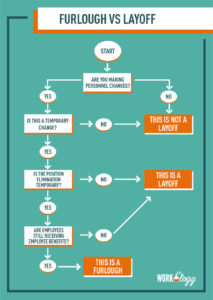Everything Employers Need to Know about Furloughs
A furlough is a temporary, unpaid leave of absence for employees due to special needs of a company or employer, which may be due to economic conditions at the specific employer or in the economy as a whole. Furloughs are (usually) temporary in nature and differ from layoffs as furloughed employees typically have either scheduled time off or return to work rights and expectations. In a furlough, employees are usually given a time frame—but not always, especially during unprecedented events like a global pandemic.
Examples of employee furloughs include closing a business for two weeks, reducing overall employee hours from 40 a week to 35, or asking employees to take a specific number of days off per month without pay. It is possible to put employees on furlough indefinitely if a company in a state with a shelter-in-place order to limit the spread of COVID-19 is deemed nonessential.
Furloughs are an option if employees aren’t essential workers and there is a shelter in place declaration only if your business doesn’t fall under the essential businesses category. What is deemed essential business varies by city and location, so it is imperative to understand your city and state regulations for a shelter in place mandate.
During furloughs, employee benefits usually continue, which is one of the ways in which furloughs are distinguished from layoffs, where benefits generally end either on the last day of work or at the end of the month. Most furloughed employees can apply for weekly unemployment benefits, depending on the unemployment insurance laws in their state. Unfortunately, in some states, the weekly payments–ranging from $235 in Mississippi up to $1,495 in Illinois–are barely enough to buy groceries.
Conversely, a layoff also often qualifies impacted employees to receive weekly unemployment benefits. However, layoffs are very different than furloughs as the employee no longer receives paid benefits and is unlikely to return to work without having to reapply and interview for a job opening at a future date. You can learn more about the differences between furloughs versus layoffs by checking out our Furlough vs. Layoff decision tree infographic at the bottom of this resource.
The Pros and Cons of a Furlough
While furloughed employees are not receiving paychecks during the furlough period, they have the general assurance that they will have jobs in the future and/or the option to continue with employer benefits during their furlough. This can provide some level of comfort, especially if employees know the furlough will be for only a short period of time. There is no guarantee that furloughed employees will return after the time off from work, but companies can be somewhat confident that they’ll have experienced workers ready to return as soon as they are able to resume business.
On the other hand, a furlough can drastically negatively impact morale and your employer brand, even if your company services are deemed non essential during a mandated shutdown. Companies will still incur costs from a furlough, as they must pay salaries for those who need to work to prepare for a furlough and those employees are typically upper management. It also takes time for businesses to come back from a shutdown period, bringing furloughed employees back to work (if they are available) or hiring and training new employees to replace those who will not return.
There is also the matter of liability. Companies can be subject to wrongful termination lawsuits related to furloughs. Employers must make sure of the choice of which workers to furlough or lay off using a sound business reason as guidance. Once determined, this should be applied consistently and is well-documented and communicated to your staff and employees. Additionally, decisions regarding whether to furlough employees on leave or immediately after a return from leave should be made with legal guidance to limit the possibility of employer liability or the appearance of bias.
Related: Bonfyre Helps Connect Remote Employees and Teams
“If you merely reduce their hours instead of reducing their actual salary in a pro rata amount, an employer will likely be liable for that employee’s salary for the work week, since salaries are paid on a weekly basis and are due in total once minute one is worked in any week. Other legal considerations include whether furloughs terminate group health insurance and trigger COBRA notice obligations (although some states are permitting employers to waiver minimum hours of service requirements under the Affordable Care Act for COVID-19 related furloughs),” shares employment attorney, Jon Hyman.
COVID-19 Related Furloughs
On March 18, the Families First Coronavirus Response Act (FFCRA) was passed in response to the spread of COVID-19. The act brings relief to states in need of funds to pay unemployment insurance to claimants. It commits $1 billion to cover the costs of processing and paying Unemployment Insurance, as well as 100% federal funding for extended benefits.
The FFCRA gives all American businesses with fewer than 500 employees funds to provide employees with paid leave, either for the employee’s own health needs or to care for family members. The legislation will ensure that workers are not forced to choose between their paychecks and the public health measures needed to combat the virus while at the same time reimbursing businesses.
The FFCRA impacts how your company handles paid leave in three ways:
- Expands the Family and Medical Leave Act (FMLA) temporarily (through the end of December 2020) to cover leave needed for the care of children out of school because of COVID-19 and also makes weeks 3 – 12 of its effective period paid leave.
- Mandates two weeks of paid sick leave for childcare and other leave related to the coronavirus.
- Provides for tax credits related to the paid leave provisions created by the act.
The new regulations apply only to certain covered employers (private employers with fewer than 500 employees, governmental agencies, and schools). These employers need to be ready to provide mandated leaves starting on April 1, 2020.
Companies of any size can furlough employees even if they don’t meet the FFCRA requirements for paid leave. You can go above and beyond the FFCRA requirements to provide financial support and assistance for your employees.
The Importance of Employee Communication During Crisis Furloughs
If you’re not communicating, you’re losing the trust of your employees and contributing to panic during a crisis. If you and your executive team don’t know what to do yet, it’s OK to communicate that you don’t but you’re working on it as fast as you can. Make sure your teams know they’re a priority for you, ahead of everything else, and that you’ll share information when you have updates (or that you’ll share “we’re still working this out” if you don’t). Bottom line, we need to be communicating with employees during this uncertain time whether it’s a layoff, furlough, or you are continuing business as usual.
“And that’s when frequent communication that meets employees where they are is needed most. Organizations must establish contemporary digital communications for employees to both deliver the information and resources they need and the human connection required to navigate these extremely challenging times.”, says Mark Sawyier, CEO of Bonfyre, a leading SaaS employee experience platform. Bonfyre is committed to assisting companies and employees facing furloughs, offering its platform as a communication channel at no cost for six months.
Four Employee Communication Phases During Furlough
As Mark mentioned, employee communication is critical during times like these. Consider developing a four-phased communication plan that outlines what you need to communicate and why:
Phase one is what’s happening right now: your employees have either been deemed essential or furloughed. They’re caught up in confusion and what they read in the news changes daily. They need to feel safe and to understand what your company is doing on their behalf. You can share how to file for unemployment benefits for furloughed employees, CDC links on how to stay safe while sheltering in place, what your state’s stay at home mandate means, how long they will have health insurance and information about COBRA.
Employers should also consider sharing resources focused on employee wellbeing, mental health, money management, and other resources to help show their support during this uncertain time.
Phase two is what will happen in 30, 60 or 90 days. If you and your executive team have worked out expectations for rehiring based on flattening the curve with stay at home orders, but don’t have an exact date yet, share that information. There is light at the end of the tunnel and if you can see it, your employees should be able to as well. This phase should be all about reassurance.
Create a cadence for regular messaging and updates focused on supporting employees, addressing employee questions and concerns, and sharing resources and information over time. These communications should not be simply one way. Remember to provide your employees with opportunities to provide feedback through question and answer sessions, surveys, and internal messaging platforms allowing them to stay engaged and connected.
Phase three is what happens when we return to work. Just as the world changed after 9/11, we are looking at a post-pandemic society and economy. If your company has been hit hard by closures and will need to phase rehiring in stages, communicate that you intend to do so, and do it realistically. If your plan is going to take months, it’s important you let your furloughed employees know so that they can plan to seek employment in another industry before their unemployment benefits run out.
Consider communication during this stage focused on plans and strategies for adding staff including rehiring furloughed employees and the resources and support they need as they transition back into the workplace.
Phase four is focused on your manager and leadership communication. Ensure that your leaders have access to information and resources to help answer employee questions. I recommend creating a frequently asked questions guide to help your leadership quickly answer questions. Offer up these resources in multiple formats to reinforce your messages including talking points, webinar presentations, and messages from your executive leadership. This ensures that communication is consistent throughout the organization. Additionally, your managers are empowered to address less complex questions freeing up HR to navigate more complex employee situations, scenarios, and questions.
“For example, let staff members know “we will send an update every day at 10 AM.” While that update may include the “we’re still working this out” message” by pro-actively updating employees you may alleviate their concern and lessen the amount of incoming phone calls or inquiries. In addition, pay attention to “where” (the channel) you will share these updates; depending upon your workforce this could be company email or intranet, personal email, or even text messaging,” shares Robin Schooling, Managing Partner of People and Strategy at Peridus Group.
The importance of having a communication plan is important especially one that leverages multiple channels. Furloughed employees are without work computers, manager emails, and access to internal company systems and platforms. Creating a central destination point for all communication such as a private Facebook group, company wiki, or a digital platform such as with the Bonfyre App.
Final Thoughts on Workplace Furloughs
Finally, a few thoughts. While you can’t pay your employees on furlough, you can choose not to oppose unemployment filings. With these federal government provisions, your business will have some support to offer paid leave before you announce a furlough as outlined in the FFCRA, and states are also being funded for offering unemployment benefits. No one can predict the future, so we don’t know how long a furlough may last. But it can help your employees to plan for a longer furlough rather than a short one so you don’t have to repeatedly extend the date for rehire. Compassion is key and when we see the other side of this crisis, how you handle a furlough is what your employees will remember about your company.
Original article published on the Workology blog.



 6 min
6 min





